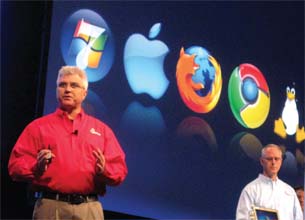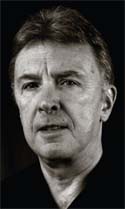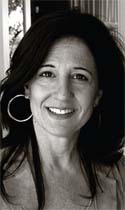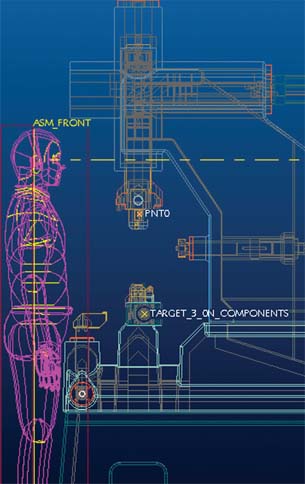Latest News
May 1, 2010
By Kenneth Wong
 After making a splash at SolidWorks World 2010 by previewing what seems like SolidWorks running in Mac OS, the company reveals it has no definite timetable on when it’ll be available. |
Every morning, I wake up to an inbox brimming with story pitches. Most of them are from marketing and PR people urging me to write about their clients’ projects and products. As it happens, I am looking for a story, one that will complement the upcoming special supplement on simulation and analysis (scheduled for October 2010). But before you fire off an e-mail in my direction, please read. I’d like you to make the pitch without words.
That’s right. For this one, I’ll only consider pitches in movies. What’s that? You don’t have a camcorder, a film crew, or a budget for special effects? No need. I’m talking about the short 10-15 second movies you export out of an analysis program.
Here’s what I’d like to see. A movie showing the results of FEA, CFD, stress tests, or any other kind of simulation. The more spectacular, the better. Essentially, I’m looking for exemplary or unorthodox use of computer-aided analysis. Show me twisted metal plates, collapsing vehicle frames, and airborne assemblies in colored contours and animation. Show me your most impressive displacements, shears, and Von Mises.
Please don’t e-mail me those clips as attachments, by the way. My e-mail server simply won’t be able to cope with that kind of traffic. You can upload them to DE Exchange, our new online community at deexchange.ning.com, then e-mail me the link with a subject line that reads, “DE story pitch.” No explanation, no background, no preface, just the link to the movie and your contact info. As an alternative, you may also upload it to YouTube, then e-mail me the link in the same fashion. I’ll pick one that piques my curiosity the most, then contact the sender to develop it into an article.
My inbox is now open. I look forward to view your submissions.
Echoes From COFES 2010
Every year, people who influence the future of engineering technologies—developers, innovators, and industry watchers—get together to discuss, argue, and debate the hot-button issues everyone is grappling with. The event is known as Congress on the Future of Engineering Software (COFES; cofes.com). This year, when it convened last month, the congress took up cloud computing and sustainability, among other topics.
The following excerpts are from interviews I conducted with Jon Peddie, self-professed pixel-chaser from Jon Peddie Research (JPR; jonpeddie.com), and Terry Swack, cofounder and CEO of Sustainable Minds (sustainableminds.com), both participants of COFES 2010.
 Jon Peddie from Jon Peddie Research discusses cloud computing at COFES 2010. |
Jon Peddie to Walk on Cloud
Can we come up with a working definition, or clarify what we mean when we say, “cloud computing”?
Peddie: Keep in mind, the cloud is just a synonym for the Internet. Think of the cloud as a source of computing power, as we think of utility companies as a source for electrical power. We don’t have electrical generators in our backyards. Why do we have powerful computers? With the Internet being so ubiquitous, so fast—with high-speed Internet in the home, at work, via DSL, cable, etc.—we really can do ]in the cloud] a lot of the things we would ]previously only] do on local machines. You now have ultimate mobility…. You now have access to your documents wherever you are; you’re not chained to your desk or your office with a big, expensive machine…. ]We] always get tripped up on the definition. We could probably spend an hour with a whiteboard, coming up with what the definition of cloud is, but as soon as we show it to another person, we’d have to change it.
What would you say are the downsides associated with cloud computing?
Peddie: The first one that always comes up is, someone will say, “I don’t trust cloud computing because I don’t have confidence in ]the provider’s] security,” or “I’m unwilling to allow my personal data or secret sauce or whatever that I value and think of as precious out of my immediate control.” I find that a ridiculous argument. My response to that is: Where is your 401K? Where’s your mortgage? You don’t know where that is…. The point is, you already are exposing yourself to an enormous amount of cloud ]computing] with no control, with large sums of dollars, and you feel comfortable doing that. How many times have you bought something online or entered your social security number? That goes into the cloud. If you’re doing anything online—email, downloading videos from YouTube, paying bills, or buying items—you are using the cloud.
The idea that we have to buy bigger and bigger computers, that we have to ]upgrade to] more powerful devices every year or we’ll fall behind and our operating systems won’t work anymore—I think that model is breaking apart.
 Terry Swack from Sustainable Minds helped organize the Design and Sustainability Symposium at COFES 2010. |
Terry Swack on Sustainability
Is there a difference between designing something for compliance, and designing something to make it more environmentally friendly and sustainable?
Swack: At the highest level, compliance is about executing something specifically for some type of legislation or guideline or label. In the green building industry, there’s a phrase for designing to code. It’s “barely legal.” ]Codes and regulations] are usually the result of a group of people coming to consensus, typically on the lowest common denominator. So it’s the minimum threshold…. Designing something to be sustainable or to be environment-friendly is really an opportunity for product innovation, to look across the product lifecycle, to see where environmental performance could be improved, therefore to transform the product or system you’re designing.
You’ve said there’s no such thing as a green product, only greener products.
Swack: All products use materials and waste energies. There’s no such thing as a green product. They all consume stuff. But things can be compared. And through that comparison, you can determine what makes a product greener…. We’re very careful to not call something “a green product,” because they just don’t exist.
What are the topics that don’t get discussed enough? What do you hope people will bring up at the Design and Sustainability Symposium ]part of COFES]?
Swack: Green-washing has become a popular accusation. So the antidote to green-washing is metrics and transparency. The topic on everyone’s plate right now is, how do you measure environmental performance, what should you be measuring, what are those metrics? Are we using consistent data sets in the engineering design tools developed that will allow comparability and comparison independent of the tool or application? So it goes to the fundamental building blocks—the input that goes into what we call system bill of materials.
 Does the Pro/ENGINEER digital manikin look like a Bob or an Edi to you? If you were asked to name it, what would be your choice? |
Any advice for engineers/designers thinking about how to make products greener?
Swack: To design sustainable products, everyone has to be thinking the same way. We have to start designing systems, not just artifacts. We need to design whole product lifecycles, from raw material acquisition to end of life. So the starting point to designing greener products is to change the way you think about designing.
To listen to the podcasts in their entirety, please visit Virtual Desktop blog (deskeng.com/virtual_desktop/) and search for posts titled “Jon Peddie to Walk on Cloud” and “Terry Swack on Sustainability.”
Uncertainty Surrounds SW on Mac
Hold your applause for SolidWorks on Mac! It may be premature. After previewing what looked like SolidWorks running inside Mac OS at SolidWorks World 2010 in February, the company revealed it can’t commit to delivering a native Mac version of SolidWorks in the foreseeable future.
“Mac users will have better access to tools from Dassault Systemes SolidWorks in the future; however, we have no plans for our SolidWorks CAD product as it exists today to become available as a native Mac application,” said Fielder Hiss, SolidWorks’ VP of product management.
So what exactly did the presenters show the audience during the main stage presentation? According to Hiss, they demonstrated “]cloud-]hosted versions of prototype applets running on ]a PC with] Windows 7, on a Wacom tablet, on an all-in-one Mac workstation, a netbook, and an iPhone.”
Pro/Manikin 2.0 The community came up with quite a few. Vladimir recommended “Edi.” PTC fan Bob (understandably) was partial to “Bob.” Sandy Joung, PTC’s senior director of product marketing, chimed in: “What about the girl manikin?” she asked. As a pair, the male and female manikins might be dubbed “Manuel Manikin and Mandy Manikin,” replied someone. Another variation currently in the running was “Manie and Mandy Manikin.” To put in your own two cents, search for Pro/ENGINEER – Did You Know? on Facebook. |
This, however, contradicts SolidWorks CTO Austin O’Malley’s explanation of the technologies shown at the conference. At SolidWorks blog, he wrote, “The iMac and Windows 7 devices were running native implementations of the software, while the netbook was accessing a hosted version of the software through a thin client interface.” (see “More on the New Technology Shown at SolidWorks World 2010,” Feb. 23, 2010, at blogs.solidworks.com.)
The point of demonstrating with multiple platforms, Hiss explained, was to show that “with cloud-based technology, platform is irrelevant. Essentially, it lets people use any device they feel comfortable using.”
Browser-accessible, hosted software doesn’t rely on the operating system of a user’s machine to boot and run, so it’s bound to be available to anyone logging in using a supported browser. But placating Mac fans with this approach is, at best, a compromise, because it doesn’t take full advantage of Mac hardware and OS.
“We developed ]these preview codes] to be platform-independent,” said Hiss, “but if we choose to—at any time—deliver them as native versions, we can deliver them as native Mac, Linux, Windows versions.” The prototype code and applets demonstrated at the conference, he added, are all fully functional (in other words, not mock-ups representing concepts).
At SolidWorks World, one thing became abundantly clear to developers. “There are lots of people excited about Mac,” acknowledged Hiss. “We continue to watch ]the platform], prototype things ]for it], but we just don’t have a time line on exactly when we can deliver these as products.”
Kenneth Wong writes about technology, its innovative use, and its implications. One of DE’s MCAD/PLM experts, he writes DE’s Virtual Desktop blog at deskeng.com/virtual_desktop/. You can follow him on Twitter at KennethWongCAD, or send e-mail to [email protected].
Subscribe to our FREE magazine, FREE email newsletters or both!
Latest News
About the Author
Kenneth Wong is Digital Engineering’s resident blogger and senior editor. Email him at [email protected] or share your thoughts on this article at digitaleng.news/facebook.
Follow DE





